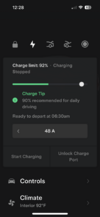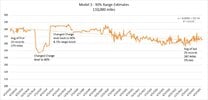Aakee:
Two questions:
1) Am I to take away from this that battery temperature is also important? I see a battery at 25C has significant less calendar aging than one at 50% (other things being equal).
Calendar aging can be described as = Time x SOC x Temperature.
Of course the rate is not completely proportional to the SOC, but to understand how it works it might be good.
Reduce time or
Reduce temperature or
Reduce SOC
And the calendar aging will reduce.
The temperature dependant part can be seen as depending on the Arrhenius equation.
2) Looking at the charts you post, they seem contradictory. The first shows quite a bit of aging over 80%, a notable increase over ~95%. The second contradicts this, showing a marked dip at 80% and improveing again as SoC increases. Which are we to use as "bottom line"?
For common understanding, use the one with about the same degradation above 60% for NCA. Its a good way to see it.
For the difference between these two charts, almost any chart shows signs of that the calendar aging is less at 100% than at 75-90% if the temperature is not to high.
For shorter time, like the 2.1 month line, all three chemistries show that behaviour. I guess its pissible to see that?
As we do not in general leave the cars for
Months at 100% SOC, we can guess that the short term behaviour could be more like that at 100%.
I usually use the pictures with “worse at 80%” to make it very clear that 100% is not very very bad, and that 80% is not very very good.
There is more than one example of seeing kower degradation at 100%.
This is Panasonic 18650 NCA cells.
The takeaway is that there is no babying part keeping the battery at 80% or so.
To reduce the calendar aging, stay at 55% or lower. (most people can not affect the ambient temperature).
And, that the urgency to drive asap after a full charge is not really true.
For the common understanding, I’d say that the calendar aging is virtually the same at 70-100%, unless in very high ambient temperatures. In that case it is slightly higher at high SOC, but not by far.




